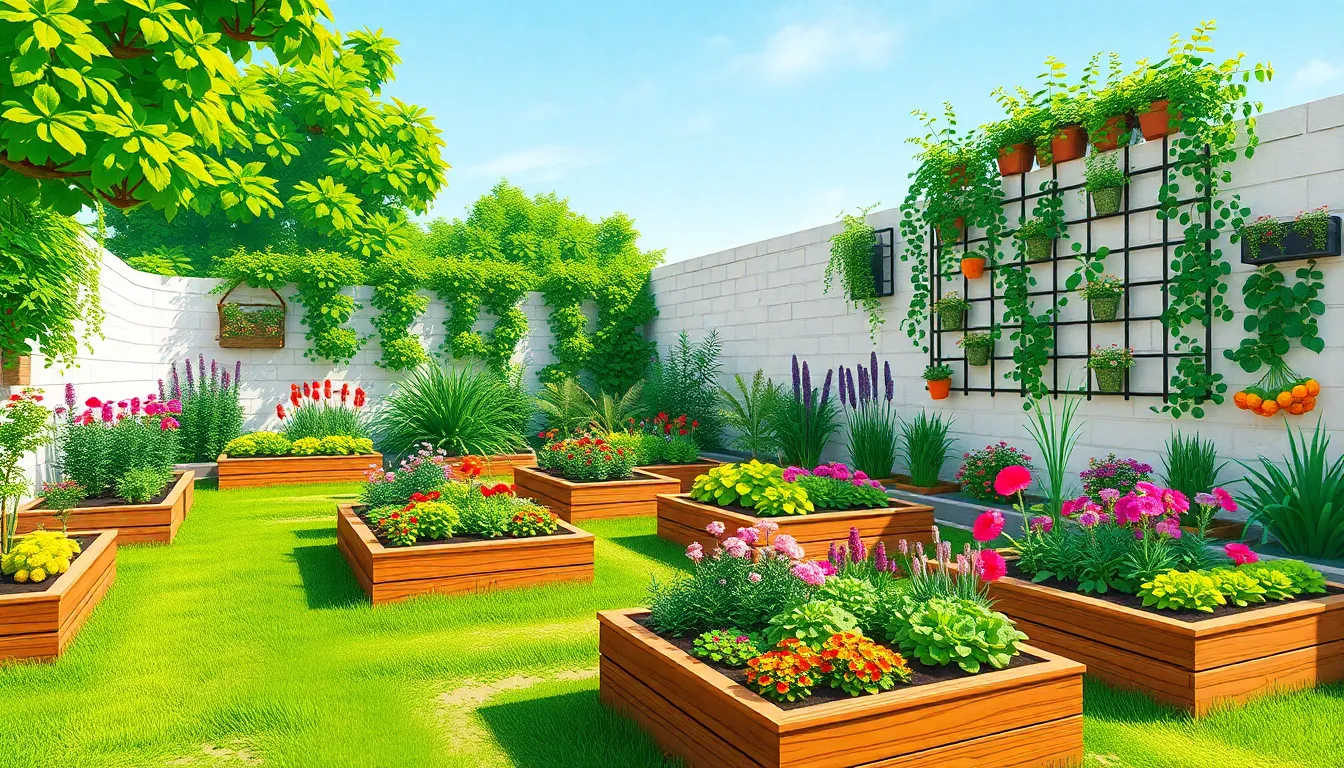Transforming a garden into a personal paradise doesn’t have to be a daunting task. With the right layout ideas, even the smallest space can bloom into a vibrant retreat. Whether it’s a cozy corner for morning coffee or a sprawling area for evening gatherings, the possibilities are endless.
Popular Garden Layout Ideas
Garden layouts vary widely, offering unique aesthetics and functionality. Exploring different styles can help in creating a personalized outdoor space.
Traditional Cottage Garden
A traditional cottage garden features dense plantings and diverse flowers, often including roses, hollyhocks, and lavender. This layout encourages a free-flowing design that blends color and texture. Pathways constructed from bricks or stones invite exploration, while climbing plants can adorn trellises and fences. Curved borders enhance visual interest, creating a picturesque environment where nature thrives. Gardeners often integrate seating areas, allowing relaxation amidst blooms. This style embraces a casual, welcoming atmosphere ideal for unwinding.
Contemporary Minimalist Garden
A contemporary minimalist garden emphasizes simplicity and clean lines. This design prioritizes functionality, showcasing geometric shapes and limited plant selections. Hardscaping materials like concrete and gravel define areas, promoting a sleek appearance. The focus shifts to textures and colors, often utilizing plants like succulents, ornamental grasses, and bamboo. Open spaces invite light and air, fostering an uncluttered feel. This layout supports outdoor living with streamlined furniture and fire pits, encouraging social interaction in a serene environment.
Functional Garden Layouts

Creating functional garden layouts helps optimize space use while enhancing visual appeal. These layouts accommodate various activities, from gardening to relaxing.
Raised Garden Beds
Raised garden beds offer effective solutions for organizing plants. They elevate soil for improved drainage and accessibility. Creating distinct sections within the garden can simplify maintenance and crop rotation. Gardeners enjoy the ability to customize bed dimensions based on available space or plant types. Such configurations minimize weeds and pests, resulting in healthier plants. Adding pathways between the beds enhances comfort while tending to the garden. Constructing raised beds from wood, stone, or recycled materials provides aesthetic variety.
Vertical Gardening Solutions
Vertical gardening solutions maximize space usage, perfect for smaller areas. Utilizing trellises, wall planters, or hanging pots creates a lush environment. With climbing plants like beans or tomatoes, vertical gardens promote air circulation and sunlight exposure. Incorporating these elements allows for creative displays of flowers or herbs. These gardens also find homes in urban settings, where traditional ground space is limited. Vertical gardening encourages efficient use of height while transforming walls into green showcases. Choosing drought-resistant or low-maintenance plants ensures sustainability and ease of care.
Creative Garden Zones
Creating distinct zones enhances a garden’s functionality and appeal. Gardeners benefit from organizing areas dedicated to specific activities.
Relaxation Areas
Designating relaxation zones invites tranquility into the garden. Comfortable seating areas encourage enjoyment of nature, often featuring benches or hammocks. Adding shade can improve these spaces, making them perfect for warm afternoons. Surrounding these areas with flowering plants or calming greenery fosters a peaceful atmosphere. Furthermore, incorporating water features, such as small fountains, enhances the overall sensory experience. Many find that including soft lighting transforms these zones for evening relaxation, extending usability after sunset.
Vegetable and Herb Sections
Allocating space for vegetables and herbs supports sustainability and healthy eating. Raised beds enable easy access and improved drainage for optimal plant growth. Selecting a variety of vegetables ensures a continuous harvest throughout the season. Herbs, such as basil and rosemary, add flavor to meals and attract beneficial pollinators. Using companion planting techniques enhances growth while minimizing pests. Designing these sections within easy reach of the kitchen simplifies meal preparation, reinforcing the connection between gardening and cooking.
Tips for Planning Your Garden Layout
Planning your garden layout requires careful consideration of various factors. Following these tips can help create an inviting space that’s both functional and beautiful.
Assessing Available Space
Evaluate the garden area first. Measurements determine the overall dimensions and shape, guiding the design process. Observe the sunlight patterns; certain zones may receive more sun than others, guiding plant placement. Soil quality matters too. Testing soil pH and nutrient levels helps in choosing appropriate plants. Consider existing structures, paths, and trees; these add character while influencing layout. Additionally, check local climate conditions; they affect plant growth and compatibility. Understanding limitations fosters creative solutions that maximize enjoyment.
Choosing the Right Plants
Select plants based on site conditions. Native plants thrive in local climates, require less maintenance, and support biodiversity. Consider seasonal interest; incorporating various species ensures year-round beauty. Choose a mix of perennials and annuals to create visual variety and longevity in garden design. Pay attention to growth habits; tall plants often work well in the back, while low-growing plants suit the front. Group plants with similar water and light needs for better management. Finally, don’t forget to include herbs or vegetables; these add functionality and enhance garden appeal.
Creating a stunning garden is an achievable goal for anyone. With thoughtful layout ideas and a clear vision, even the smallest spaces can transform into vibrant retreats. By selecting the right plants and incorporating functional zones, gardeners can enhance both aesthetics and usability.
Whether opting for a traditional cottage garden or a sleek minimalist design, the key lies in personalizing the space to reflect individual tastes and needs. Embracing innovative solutions like vertical gardening and raised beds not only maximizes space but also fosters a connection to nature.
Ultimately, the right garden layout can elevate outdoor living experiences, making every moment spent in the garden a true delight.
